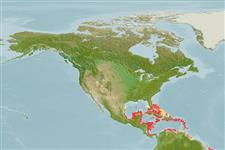Environment: milieu / climate zone / distribuzione batimetrica / distribution range
Ecologia
marino associati a barriera corallina; distribuzione batimetrica 12 - 35 m (Ref. 9710). Tropical
Western Central Atlantic: southern Bahamas, Hispaniola and the Virgin Islands to Venezuela.
Size / Peso / Age
Maturità: Lm ? range ? - ? cm
Max length : 12.0 cm TL maschio/sesso non determinato; (Ref. 9710)
Short description
Chiavi di identificazione | Morfologia | Morfometria
Spine dorsali (totale) : 21; Raggi dorsali molli (totale) : 12; Spine anali: 2; Raggi anali molli: 22; Vertebre: 37 - 38.
Body shape (shape guide): elongated.
Inhabits deeper reefs with abundant algae (Ref. 9710). May be easily approached (Ref. 9710).
Life cycle and mating behavior
Maturità | Riproduzione | Deposizione | Uova | Fecundity | Larve
Lieske, E. and R. Myers, 1994. Collins Pocket Guide. Coral reef fishes. Indo-Pacific & Caribbean including the Red Sea. Haper Collins Publishers, 400 p. (Ref. 9710)
IUCN Red List Status (Ref. 130435: Version 2025-1)
Threat to humans
Harmless
Human uses
Strumenti
Special reports
Download XML
Fonti Internet
Estimates based on models
Preferred temperature (Fonte Biblio.
123201): 26.4 - 28, mean 27.6 °C (based on 40 cells).
Phylogenetic diversity index (Fonte Biblio.
82804): PD
50 = 0.5078 [Uniqueness, from 0.5 = low to 2.0 = high].
Bayesian length-weight: a=0.00537 (0.00222 - 0.01301), b=3.08 (2.87 - 3.29), in cm total length, based on LWR estimates for this (Sub)family-body shape (Ref.
93245).
Trophic level (Fonte Biblio.
69278): 3.9 ±0.7 se; based on size and trophs of closest relatives
Fishing Vulnerability (Ref.
59153): Low vulnerability (10 of 100).
🛈
Nutrients (Ref.
124155): Calcium = 112 [58, 174] mg/100g; Iron = 0.7 [0.4, 1.2] mg/100g; Protein = 18.4 [17.3, 19.4] %; Omega3 = 0.102 [0.059, 0.175] g/100g; Selenium = 28.3 [12.6, 58.3] μg/100g; VitaminA = 143 [48, 422] μg/100g; Zinc = 1.87 [1.24, 2.62] mg/100g (wet weight);
